Sagittal suture
| Sagittal suture | |
|---|---|
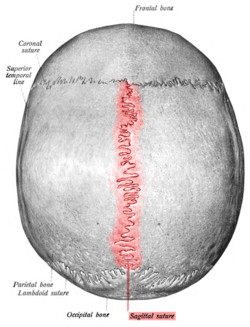 Human adult skull from above. | |
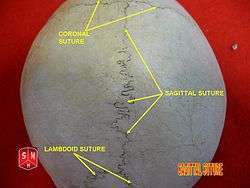 Human adult skull from above. Sagittal suture labeled at center. | |
| Details | |
| Identifiers | |
| Latin | sutura sagittalis |
| TA | A03.1.02.003 |
| FMA | 52929 |
The sagittal suture is a dense, fibrous connective tissue joint between the two parietal bones of the skull. The term is derived from the Latin word sagitta, meaning arrow. The derivation of this term may be demonstrated by observing how the sagittal suture is notched posteriorly, like an arrow, by the lambdoid suture. The sagittal suture is also known as the interparietal suture and the sutura interparietalis.
In forensic anthropology, the sagittal suture is one method used to date human remains. The suture begins to close at age twenty-nine, starting at where it intersects at the lambdoid suture and working forward. By age thirty-five, the suture is completely closed. This means that when inspecting a human skull, if the suture is still open, one can assume an age of less than twenty-nine. Conversely, if the suture is completely formed, one can assume an age of greater than thirty-five.
Two anatomical landmarks are found on the sagittal suture: the bregma, and the vertex of the skull. The bregma is formed by the intersection of the sagittal and coronal sutures. The vertex is the highest point on the skull and is often near the midpoint of the sagittal suture.
At birth, the bones of the skull do not meet. If certain bones of the skull grow too fast then "premature closure" of the sutures may occur. This can result in skull deformities. If the sagittal suture closes early the skull becomes long, narrow, and wedge-shaped, a condition called scaphocephaly.
Additional images
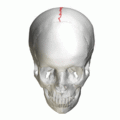 Animation. Sagittal suture shown in red.
Animation. Sagittal suture shown in red.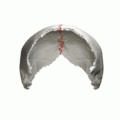 Left and right parietal bone.
Left and right parietal bone. Sagittal suture seen from inside.
Sagittal suture seen from inside. Sagittal suture of a new-born child, seen from above.
Sagittal suture of a new-born child, seen from above. Sagittal suture of a new-born child.
Sagittal suture of a new-born child.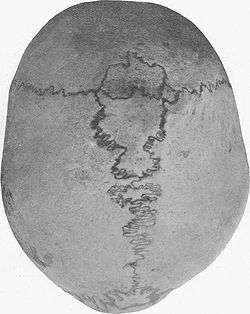 Sagittal suture with wormian bones.
Sagittal suture with wormian bones.
References
- "Sagittal suture", Stedman's Medical Dictionary, 27th ed. (2000).
- Moore, Keith L., and T.V.N. Persaud. The Developing Human: Clinically Oriented Embryology, 7th ed. (2003).
External links
| Wikimedia Commons has media related to Sagittal sutures. |
- Anatomy figure: 22:03-01 at Human Anatomy Online, SUNY Downstate Medical Center
- Anatomy image: skel/behind2 at Human Anatomy Lecture (Biology 129), Pennsylvania State University